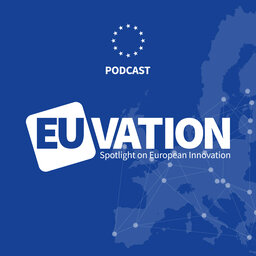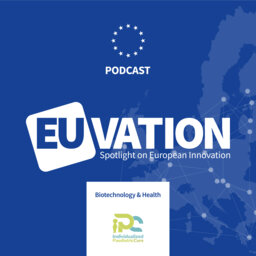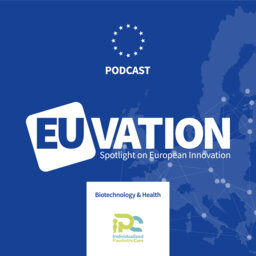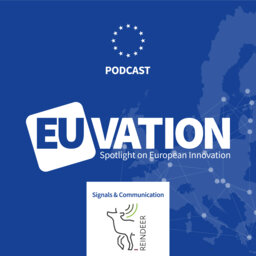Car2TERA (4) H2020 Project: Checking in with Jonas Hansryd & Yinggang Li from Ericsson
In this episode we speak with with Jonas Hansryd & Yinggang Li from Ericsson about the progress of the Car2TERA project. They share some details about why this project is so important for the future of automobiles and what Ericsson is doing to push this effort forward.
The Car2TERA project has received funding from the European Union’s Horizon 2020 research and innovation programme under grant agreement No. 824962.
This is a Technikon podcast.
Every day we get behind the wheel and rely on our cars to safely take us to wherever we want to go. Our cars are an amalgam of decades of best practices intertwined with the latest technology. And from this, we get the modern automobile, which is undoubtedly right now at the pinnacle of auto safety. But what's next? Where do we go from here and what will it take to get there? I'm Peter Balint from Technikon. And today we look at the Car2TERA project. When you look to the future of automobiles, what do you see? If you said autonomous driving, you would be in the majority. While we can all see the benefits of the partially or fully autonomous vehicles, the amount of research on the topic which is happening at this moment is absolutely astounding. And it's mostly in the name of safety. Imagine, for example, an in-cabin radar sensor which knows what each passenger is doing at any given time; sleeping, reading upright or reclined. Using these instantaneous data points, the car's computer can decide the most effective sequence of airbag deployment in case of collision. The speed at which this happens is the business of Car2TERA - as you can imagine, it's got to be fast. Exploring sub terahertz frequencies and lightning fast communications are a few of the goals in this project. I recently had the opportunity to sit down with Jonas Hansryd and Yinggang Li from project partner Ericsson in Sweden, which of course is a global provider of ICT equipment and services. And as it turns out, our automobiles are quickly becoming complex communication centers on wheels. As such, they must be outfitted with the right stuff. Let's have a listen. Welcome, gentlemen, and thanks for joining me today.
Thank you, Peter.
You're welcome.
From Ericsson's point of view, why is this project important? Or, in other words, what is the problem to solve and how will the discoveries in Car2TERA help find answers? And we'll start with you Jonas.
Thanks. This is really key, of course, a key question, and I think we all are aware that we have a continous increase in the amount of digital data that we are processing in this society and in the telecom business we see the same same kind of problem there and in particular with the when we have more, more and more advanced radios and more wider and wider bandwidth that we need to to support and we have a... able to introduce more and more advanced features like beamforming and different types of MIMO systems. We need to process a lot of data. We have already reached terabits per second that we need to process inside our radios. So it's a lot of data to transport around. And this takes both a lot of energy and generates a lot of a lot of heat that we need to be able to handle. So today we do this using traditional copper lines, or we can also use fiber optic technology using lasers. The problem with copper is that it's quite limited in bandwidth, so that is the bottleneck going to wider bandwidth and more more advanced radios. The problem with optics is both that it's quite an expensive technology and also the our radios are becoming quite quite warm. And that is also something we see a lot of different industries like data centers, automotive and need ... in order to introduce optics, optics is a quite temperature sensitive technology. You cannot... you cannot have too high temperatures inside the equipment, so you need to take care of that heat in some way and that this expensive and costly if you want to use lasers. So with the technology that we are trying to develop in Car2TERA here, we are trying to make something that is an alternative to both copper and optical communication. We use real high frequencies, terahertz frequencies and are trying to guide it in plastic waveguides. So it would be an alternative to optical and copper technology. And that will solve... if you can make that kind of technology, and it would solve a lot of problems for us when we are building our radios.
Yinggang, can you add anything?
I just want to emphasize what Janas talking is, the short range, high speed data link we are talking about within the product and so on.
So let's zoom out a bit and look at the benefit of Car2TERA , to the citizen and technology sectors in the EU. Yinggang, can you tell us more?
Yes. Following what Jonas said about the tremendous amount of data the society's consuming now, I just want to add one note that the high speed data links are needed not only for telecom communications, but also for many, many other industries, including, for example, data center security imaging sensors and automotive radars, which which is a very active areas nowadays also, and therefore the relevance to consumers, end users -the general citizens will benefit a lot in economically and in environmentaly from the development of these cost and energy efficient solutions, but transferring this huge amount of data is also consumes a lot of energy and created a lot of heat. So it is also environmentally important to develop this kind of energy efficient solutions. So the whole citizens and I think consumers will benefit from this and from a more technology research aspect for the European Union, I think the research carried out in Car2TERA will position Europe as at the forefront of the field of Terahertz, Terabit datalink Technologies.
We should not also forget that the Car2TERA is... we have two different demos trators that we're trying to build -the common denominator for for these two technologies is really terahertz frequencies right that we are trying to to use the features and trying to tame terahertz frequencies then they make useful applications for both of these really high frequencies and the benefit of terahertz... I mean, if if we can use terahertz technology it has a lot of really interesting things we can do with it. I mean this the really short wavelength gives us the possibility to make radars with really, really high resolution, as we're trying to do in in the first demonstrator that we're working with here in Car2TERA . That would be an in-vehicle sensor trying to see and find where the passenger inside the car is placed and what that first is doing -is breathing or alive and what is happening during like if we have some kind of collision. And so something that is you can you can make radar with extremely high resolution, something that is not possible to do with microwave or millimeter wave frequencies. So that is really exciting. And I think and the other application, as we said, I mean that is these for for like quite short interconnects, really high capacities, short interconnects that would be an alternative and more temperature and the low cost alternative to the optics and the wider bandwidth alternative than compared to classic copper interconnects. So I think I mean, trying to understand how we can build the terahertz systems is really the key here of of Car2TERA and that is what really will benefit the citizens of the European Union, we will really... with Car2TERA I mean, this is one of many terahertz product in the world right now trying to investigate what we can do with terahertz frequencies. I think this is one of the leading projects and if we really bring European Union in the forefront of this technology area.
So based on what you are saying, sub terahertz technologies are being widely studied and researched. And even though Car2TERA is focusing on the automobile, the discoveries and advancements could impact any number of related or even unrelated industries.
Yeah, absolutely. I really believe that and I think I mean, we want to apply for the second demonstrator here that we're trying to build the the short range inter connect. I mean that one can be applied both in automotive and telecom and in data centers, in the high performance computing. So the market for that kind of technology is is huge. Once we have taken it to a sufficiently high maturity level, that is the direction that we are going in for sure and we will reach that, I think, in the coming five to ten years. I'm personally convinced about that.
Knowing there's a strong market in this field is like the light at the end of the tunnel, I suppose. Yin-Yang, maybe you can answer this. As stated earlier, Car2TERA is an effort to aid in the design of automated vehicles. And as we have discussed in earlier episodes, this means the project focuses on two specific areas. Number one being a new type of car radar sensor for inside the vehicle. And secondly short distance high data rate Terahertz over plastic data links for telecommunication which one of these is Ericsson focused on.
First of all, you said that Car2TERA is an effort to aid in the design of automotive vehicles. It is correct, but not quite accurate. The more accurate statement is, the project aims to develop the hardware of technologies, more specifically hardware integration platform, which should be applicable to many different systems in various industry areas. Automotive vehicles and telecom are just the two typical examples picked up by the project. But the technology to be developed in Car2TERA should not be limited to ways to to use cases. Talking about the Erissson's focus I mean, for obvious reasons, Ericsson's focus is on the short range, high speed data links based on these plastic fibers and that we are talking of using, as Jonas mentioned already, using terahertz frequencies and also talking of a speed typically above 100 gigabits per second towards tera bit per second data speed.
Thanks, Yinggang, for that clarification. Car2TERA is using the sub terahertz frequency spectrum. Where else do we see these kinds of super high frequency communications nowadays?
I think we I think we were into this a little bit earlier here, Peter, that I mean, I think we can see a big need for this in many areas really taking, for instance, image processing where we have the in in graphical processing units, GPUs connection between if you have multicore solutions there and how to connect the different graphics and processors is one interesting area that it would be would be helpful for this inside the... inside cars. Also for satellite communication that would be able to need for this. And, of course, data centers.
I think first of all, first of all, let me say what we mean by sub terahertz frequencies on the spectrum, horizon from 100 gigahertz up to like, say typically a few hundred gigahertz saying 350 years someone might OK, up to 500 gigahertz. This is really a hot research topic nowadays; in addition to the wired short range high speed data links we are keeping talking about in this podcast, in Car2TERA and - there are more applications of this type of terahertz communications for example, the for this laser spectrum is considered right now and already proposed for involved 5G. And even 6G wireless access in mobile communications in future. So let's say about 10 years, it's very, very unlikely that the mobile phones in our hands properly are using frequency, use the sub terahertz or even terahertz bands. However, using these bands is not new and traditionally sub terahertz and terahertz have been used already in imaging and sensing applications for security applications and for materials investigations such as ... to determine the water content and that is usually in the materials, for example.
So sub terahertz frequency spectrums have been used in various industries for quite some time. Let's focus back a little bit towards automobiles. Just a few years ago, automobiles had minimal built in communication, hardware and sensors, and this is now changing rapidly. Can you give us an idea of how these communication devices and sensors will be used in the future?
First of all, I have to say I am not an automobile expert, but I totally agree with you that that the things that are happening, and changing very rapidly there as well, like like a telecom industry. As as far as I know, future vehicles in particular, the self-driving cars requires sensing and a radar system that must operate in a cooperative way for both in-car and out car sensors and radars covering the whole 360 degrees surrounding environment. So, the short range high speed data link devices be developed in Car2TERA should find their application values there as well to support that coordinate car radar systems. For example, if you have sensors and various types of sensors on the radars surrounding the car and you need a central processing for the images to make decisions there, and then you need to link to and directly to transfer the high speed data from the radar to the central processing. So that is where devices to be developed in Car2TERA can be found very valuable. Another aspect is that if you're looking for the future, the automotive industry and the telecom industry, we are moving closer closer to each other. It's actually happening nowadays is the moving closer are closer to each other in terms of the tremendous communications that that we're helping with with the vehicle. In addition to in-car communications, the two industries are now today's nowadays working together in R&D to formulate as basis of for example for wireless remote vehicle control, vehicle to vehicle communication, what is called a V2E vehicle to infrastructure, communication called V2I and even a vehicle to two areas in communication V2X . So this is a this is a very active research area around these two industries and Ericsson of course, is a very active player in this field and it is active cooperation with the local vehicle companies in Sweden and proceeding to carry out the research and development right now.
This is very interesting the narrowing gap between automobiles and communications, Jonas do you have anything to add?
Yeah, maybe. Maybe I can just add a few things here. I think I mean, to have these large number of sensors and devices inside the vehicle, it's it's a it's a trend that we see in general. I wouldn't necessarily do that. I mean, we are getting access to more and more sensors and inside society, and we will try to... something that we talked about this digital twin we tried to build a digital twin in order to both to for it to be able to to monitor the performance for you, maybe as a driver inside your vehicle or... but also the possibility for it to get help or support from others when you have some problems. And in order to do that, you need to have as much information as possible to try and make as good pictures as possible out of your vehicle or of your place that you want to to to monitor in the society. And really, what is driving all of this is really the connectivity that you have the possibility to connect all of these devices and sensors, and that is something... that is an area where Ericsson is extremely active in both automotive , but also the society in itself and to be able to connect a lot of devices and sensors that is something that is important both in in 5G and 5G gives you a lot of tools to do that, but also with sixth generation of mobile technology. So it is a general trend that we see this, that we will have more and more sensors around us that will help us and support us.
OK. So and as you say, the sensors yeah, this is fine, but they all have to be connected in some way, and it sounds like this is kind of your push in Car2TERA.
The connectivity... I mean, both connectivity that we can really connect that to them in an energy and cost efficient way.
Right. OK. And when I mentioned these projects to people, to citizens of the EU, a question that's often asked is, "So when do we see the results of what's happening in this project or when will this technology become a part of my daily life?" and to answer that question, we have to look at something called TRL, which is technology readiness level, and it helps to know which technology readiness level you're working in. And it goes from one to nine and one being basic research on a technology. And then as you progress to nine, it's testing more testing demonstrations all the way up to system testing, launch and operations, which means it's ready to be marketed or sold or used on a commercial basis. So knowing this, where do you fit in on the TRL as far as the work that you're doing in Car2TERA ?
Yes. So the goal of both both demonstrators in Car2TERA is to cross TRL 4 if we can reach TRL 5, that would be really good. But the goal is really to cross TRL four, which is a small scale prototype.
I think I think Jonas is right, we should see above TRL 4 exactly whether it is a five or six. It's very, very difficult to do a exact mapping, but our target is developing a demonstrator system at which I would not call the product prototype yet. But the one thing I want to comment is our specifications or requirements for the demonstrator are based on system requirement from Ericsson's real product perspective. That is, we could assume with enduser as always in the EU project, like Car2TERA, an enduser like Ericsson where we normally do, or almost always to provide system requirements based on real applications. So we are currently not we are not developing only lab and laboratory results, but we want to make... make sure that every technology method process developed in this project will be possible to commercialize for mass production and also for commercialization so that it that is good to the what is good, I think with Ericsson to be involved in this Car2TERA project.
Well, marketability is certainly another aspect to throw in the mix. Making everything work together in a way that's efficient as far as costs go and efficient in terms of energy and also marketable. That's the challenge.
Yeah, I agree. That's that is a point yeah .
Well, thank you, Yinggang and Jonas for your insights into Car2TERA . This project ends early next year, and I hope we have time to talk again for an update.
My pleasure. Thank you.
Thanks a lot Peter, thank you.
Thank you. For more information about the Car2TERA project, go to car2tera.eu. The Car2TERA Project has received funding from the European Union's Horizon 2020 research and Innovation Programme under grant agreement number eight two four nine six two.
 EUVATION: Spotlight on European Innovation
EUVATION: Spotlight on European Innovation


